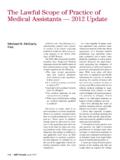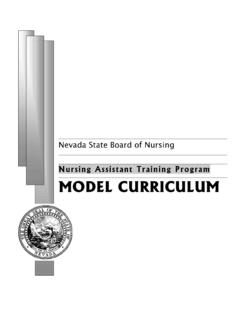Transcription of CPOE for Medication, Laboratory and Radiology …
1 1 Eligible Hospital and Critical Access Hospital Meaningful Use Core Measures Measure 1 of 16 Stage 2 Date updated: December, 2014 Table of Contents Definition of Terms Attestation Requirements Additional Information Certification and Standards Criteria Definition of Terms Computerized Provider Order Entry (CPOE) A provider's use of computer assistance to directly enter medical orders (for example, medications, consultations with other providers, Laboratory services, imaging studies, and other auxiliary services) from a computer or mobile device. Admitted to the Emergency Department There are two methods for calculating ED admissions for the denominators for measures associated with Stage 2 of Meaningful Use objectives. Find out more in this FAQ.
2 Laboratory and Radiology orders are included as part of Stage 2 for CPOE: Laboratory order order for any service provided by a Laboratory that could not be provided by a non- Laboratory . Laboratory A facility for the biological, microbiological, serological, chemical, immunohematological, hematological, biophysical, cytological, pathological, or other examination of from the human body for the purpose of providing information for the diagnosis, prevention, or treatment of any disease or impairment of, or the assessment of the health of, human beings. These examinations also include procedures to determine, measure, or otherwise describe the presence or absence of various substances or organisms in the body. Facilities only collecting or preparing specimens (or both) or only serving as a mailing service and not performing testing are not considered laboratories.
3 Radiology order order for any imaging services that uses electronic product radiation. The EP can include orders for other types of imaging services that do not rely on electronic product radiation in this definition as long the policy is consistent across all patient and for the entire EHR reporting period. CPOE for Medication, Laboratory and Radiology Orders Objective Use computerized provider order entry (CPOE) for medication, Laboratory , and Radiology orders directly entered by any licensed healthcare professional who can enter orders into the medical record per state, local, and professional guidelines. Measure More than 60 percent of medication, 30 percent of Laboratory , and 30 percent of Radiology orders created by authorized providers of the eligible hospital's or CAH's inpatient or emergency department (POS 21 or 23) during the EHR reporting period are recorded using CPOE.
4 Exclusion N/A 2 Electronic Product Radiation Any ionizing or nonionizing electromagnetic or particulate radiation, or [a]ny sonic, infrasonic, or ultrasonic wave that is emitted from an electronic product as the result of the operation of an electronic circuit in such product. Unique Patient If a patient admitted to the hospital inpatient or emergency department more than once during the EHR reporting period, then for purposes of measurement that patient is only counted once in the denominator for the measure. Attestation Requirements DENOMINATOR/NUMERATOR/ THRESHOLD MEASURE 1: MEDICATION DENOMINATOR: Number of medication orders created by the EP or authorized providers in the eligible hospital's or CAH's inpatient or emergency department (POS 21 or 23) during the EHR reporting period.
5 NUMERATOR: The number of medication orders in the denominator recorded using CPOE. THRESHOLD: The resulting percentage must be more than 60 percent in order for an EP, eligible hospital or CAH to meet this measure. MEASURE 2: Radiology DENOMINATOR: Number of Radiology orders created by the EP or authorized providers in the eligible hospital's or CAH's inpatient or emergency department (POS 21 or 23) during the EHR reporting period. NUMERATOR: The number of Radiology orders in the denominator recorded using CPOE. THRESHOLD: The resulting percentage must be more than 30 percent in order for an EP, eligible hospital or CAH to meet this measure. MEASURE 3: Laboratory DENOMINATOR: Number of Laboratory orders created by the EP or authorized providers in the eligible hospital's or CAH's inpatient or emergency department (POS 21 or 23) during the EHR reporting period.
6 NUMERATOR: The number of Laboratory orders in the denominator recorded using CPOE. THRESHOLD: The resulting percentage must be more than 30 percent in order for an EP, eligible hospital or CAH to meet this measure. A hospital must meet the thresholds for all three measures. Additional Information The provider is permitted, but not required, to limit the measure of this objective to those patients whose records are maintained using certified EHR technology. The CPOE function must be used to create the first record of the order that becomes part of the patient's medical record and before any action can be taken on the order to count in the numerator. 3 However, in some situations it may be impossible or inadvisable to wait to initiate an intervention until a record of the order has been created.
7 For example, situations where an intervention is identified and immediately initiated by the provider, or initiated immediately after a verbal order by the ordering provider to a licensed healthcare professional under his/her direct supervision. Therefore in these situations, so long as the order is entered using CPOE by a licensed healthcare professional or certified medical assistant to create the first record of that order as it becomes part of the patient s medical record, these orders would count in the numerator of the CPOE measure. Any licensed healthcare professionals and credentialed medical assistants, can enter orders into the medical record for purposes of including the order in the numerator for the objective of CPOE if they can originate the order per state, local and professional guidelines.
8 Credentialing for a medical assistant must come from an organization other than the organization employing the medical assistant . Electronic transmittal of the medication order is not a requirement for meeting the measure of this objective. CPOE is the entry of the order into the patient's EHR that uses a specific function of CEHRT. It is not how that order is filled or otherwise carried out. In order to meet this objective and measure, an eligible hospital or CAH must use the capabilities and standards of CEHRT at 45 CFR (a)(1). Certification and Standards Criteria Below is the corresponding certification and standards criteria for electronic health record technology that supports achieving the meaningful use of this objective. Certification Criteria (a)(1) CPOE Enable a user to electronically record, change, and access the following order types, at a minimum: (i) Medications; (ii) Laboratory ; and (iii) Radiology /imaging.
9 *Depending on the type of certification issued to the EHR technology, it will also have been certified to the certification criterion adopted at 45 CFR (g)(1), (g)(2), or both, in order to assist in the calculation of this meaningful use measure. Standards Criteria N/A



















